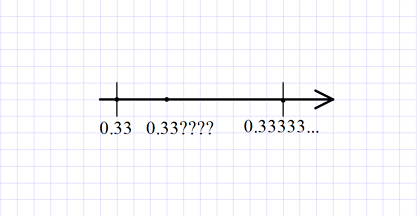Aren't they the same value?

0 . 3 3 < n m < 3 1
Find the smallest positive integer n such that there exists an integer m for which the inequality above is fulfilled.
The answer is 103.
This section requires Javascript.
You are seeing this because something didn't load right. We suggest you, (a) try
refreshing the page, (b) enabling javascript if it is disabled on your browser and,
finally, (c)
loading the
non-javascript version of this page
. We're sorry about the hassle.
5 solutions
Moderator note:
If you are familiar with the Farey sequence, can you immediately write down 2 equations (not inequalities) that m , n must satisfy?
Quickly check that 1 0 0 3 3 and 3 1 are adjacent in a Farey sequence since ∣ 3 3 × 3 − 1 0 0 × 1 ∣ = 1 .
Then we know that the number with the smallest denominator between 1 0 0 3 3 and 3 1 is 1 0 0 + 3 3 3 + 1 = 1 0 3 3 4 .
really cool!
If you simplify the equality, you get 9 9 n < m < 1 0 0 n . Using this, can't I say that m is at least 199 (because when n = 1 , m can't exist).
Cant it be 1/2
Taking reciprocals of everything, we have 3 < m n < 3 3 3 1 .
Multiplying both sides by m we get 3 m < n < 3 m + 3 3 m .
It is obvious that if we want to fit an integer n between 3 m and 3 m + 3 3 m (keeping in mind that 3 m is an integer), then m ≥ 3 4 .
Value m = 3 4 yields n = 1 0 3 (and obviously larger m yields larger n ).
Multiplying the inequality by 3 n gives
. 9 9 n < 3 m < n
That means there must be an integer that is divisible by 3 between . 9 9 n and n . Since n = 1 0 0 gives 9 9 and 1 0 0 , we know that for an integer to be between . 9 9 n and n , n ≥ 1 0 1 . The smallest integer that is divisible by 3 and greater than 1 0 0 is 1 0 2 , which is between . 9 9 ∗ 1 0 3 and 1 0 3 .
Thus, our answer is 1 0 3
Based on the fact that for b>a, n>0, b a < b + n a + n w e h a v e : − 3 1 = . 3 3 3 3 3 3 3 3 3 . So we need .33< n m < . 3 3 3 3 3 3 . 3 3 = 1 0 0 3 3 < 1 0 0 + 3 3 3 + 1 = . 3 3 0 0 9 7 0 8 7 4 < 3 1 ∴ 1 0 0 + 3 3 3 + 1 = 1 0 3 3 4 A N S W E R 1 0 3 , If we had . 3 3 < n m < . 3 3 0 0 9 5 , we would have gone for more refinement as follows. 1 0 0 + 2 3 3 3 + 2 1 = . 3 3 0 0 4 9 , a n d . . . t h e n 2 ∗ ( 1 0 0 + 2 3 ) 2 ∗ ( 3 3 + 2 1 ) = 2 0 3 6 7 = . 3 3 0 0 4 9 2 6 1 1 By refining fraction to be added and compensating. Note:- By this, we are securing our lower bound for minimum value. Fractions has to be as reciprocal of integers only.
Mediant fraction inequality states that : a/b<(a+c)/(b+d)<c/d
It's not necessarily the median
Since 1 0 0 3 3 < n m , we have 1 0 0 m > 3 3 n and therefore 1 0 0 m ≥ 3 3 n + 1 .
Since n m < 3 1 , we obtain n > 3 m and therefore n ≥ 3 m + 1 .
Hence 1 0 0 m ≥ 3 3 ( 3 m + 1 ) + 1 = 9 9 m + 3 4 and m ≥ 3 4 .
Therefore n ≥ 3 × 3 4 + 1 = 1 0 3 .
Since 1 0 0 3 3 < 1 0 3 3 4 < 3 1 , the least n is 103.